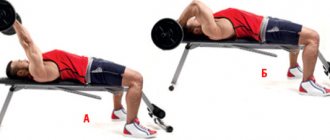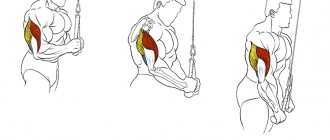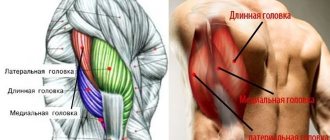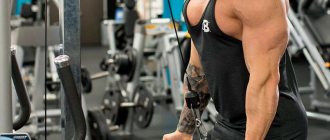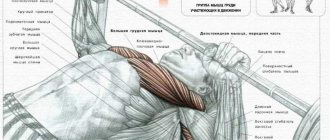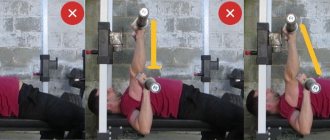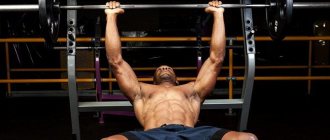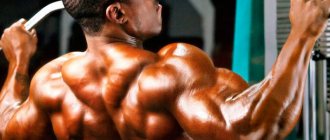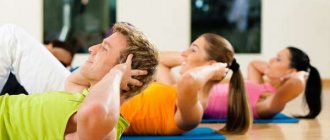Rules for performing the exercise
- Sit on a bench with a backrest. Lift the dumbbell with both hands and hold it above your head at arm's length. Hold the dumbbell with both hands on the inside of the disc, palms facing up. Important: it is better if there is a person nearby who will give you the weight, especially if the weight is large. This will be your starting position.
- As you inhale, keeping your elbows stationary next to your head, lower the dumbbell in a downward arc behind your head until your triceps are stretched to their maximum. Important: the shoulders must remain motionless, only the forearms move.
- As you exhale, return to the starting position, lifting the dumbbells using your triceps.
- Perform this exercise as many times as necessary. Variations: a) This exercise can also be done standing, but this will create tension in the back, especially if you are using heavy dumbbells. b) Another variation of this exercise is to use an EZ or straight barbell. In this case, it is necessary to hold the barbell with a narrow grip, palms forward (pronated grip). c) There is also a barbell that has parallel bars inside (often referred to as a “triceps blaster”). A similar barbell can also be used in this exercise. d) Finally, a low line with a rope or barbell (straight or EZ) at the end can also be used.
Alternative Exercises
Adviсe
- Don't use too much weight for this exercise; you'll be better off using the correct technique with a lighter weight rather than using the wrong technique with a heavier weight, which will result in less muscle contraction. If the barbell is very heavy, you will not be able to hold it with level hands at an angle of 40-50° to the vertical and you will reflexively pull your elbows forward. And this significantly reduces the contraction of the triceps.
- Fixing the upper arms in a tilt at an angle of 40-50° to the vertical is the main point of the exercise.
- Straighten your upper arms as much as possible. Otherwise, you will not reach the maximum load on the triceps.
- Although the French bench press involves all three heads of the triceps, the center of the load is precisely on the long head of the muscle. It is located on the back of the hand and stands out perfectly when looking at the hand from the side.
- It is prohibited to place your feet on the bench. They should rest firmly on the floor. Otherwise, you risk losing your balance and getting injured.
French bench press: which muscles “work”, specifics and variability of training
The French bench press is a classic isolated exercise for complex development of the triceps brachii muscle (that is, the triceps). The technique of performing the French press involves three possible positions - standing, lying and sitting (including on a bench at an angle). In this article we will look at only one of these options - in the prone position (including work with a straight and EZ bar, as well as a French press with dumbbells).
This type of training has become widespread in powerlifting and bodybuilding due to the fact that targeted work on the triceps is extremely effective. However, in addition to the triceps brachii muscle, the French press technique provides indirect “work” for a number of other muscles:
- rectus and oblique abdominal muscles;
- pectoral muscles (in particular, the upper and side parts);
- the so-called rotator cuff muscles ;
- deltoid muscles of the shoulder;
- back muscles (primarily the latissimus, as well as the rhomboid and serratus muscles);
- trapezius (mostly the lower part);
- flexor carpi radialis.
Of course, the emphasis on a specific muscle group, as well as the fundamental involvement of certain muscles, differ depending on the position of the athlete (standing, lying, sitting), the type of sports equipment (straight or ez-bar, dumbbell), amplitude and vector of movement. However, you need to understand that all these muscles act as stabilizers; they are involved to a minimal extent.
As for the options for performing the French bench press (photos below), there is only one difference between the straight barbell and the EZ bar: the specific position of the wrists when working with the EZ bar leads to the fact that part of the load is removed from the forearms. In other words, this type of training is simpler, but the effectiveness of working out the triceps is absolutely the same.
If the bar is replaced with a dumbbell, the target functionality of the exercise also does not change, but the trapezius and lats are more involved. For some, working with a dumbbell is simply more convenient, but the classic option, which is suitable for most athletes and guarantees high-quality triceps work, is the French bench press with a barbell or EZ bar. At the same time, a “crooked” bar is still preferable, since the load on the biceps muscle is maximally isolated.
The technique of the French bench press with a barbell is quite simple, but requires strict adherence to all methodological instructions. You need to understand that, despite its isolation, this exercise can be traumatic, primarily for the wrist joints. In addition, violation of technique (as in any other training) significantly reduces its effectiveness. This is the algorithm for the classic French bench press with a barbell:
- The athlete lies down on a special bench. A straight barbell or EZ bar, weighed down with the required weight, is placed on racks.
- The athlete takes the sports equipment with an upper closed grip, shoulder-width apart (if we are talking about an EZ bar, then the position of the hands is obvious).
- The athlete removes the bar from the racks and fully straightens his arms above himself. He then tilts the straightened arms back (towards the head) to an angle of approximately 45 degrees to the body.
- Shoulders and elbows remain motionless. By bending the elbow joint, the athlete smoothly lowers the bar down to the forehead or behind the head (we will return to the difference between these options later).
- After the angle at the elbow reaches 90 degrees, the athlete fixes the bar for a moment and then returns it to its original position. The algorithm is repeated the required number of times.
Please note that the technique for performing a French press with an EZ bar (video at the end of the article) is completely identical to the version with a straight barbell; there cannot be any functional differences except the position of the wrists, which is mentioned above. If dumbbells are used, you need to consider the following points:
- The French bench press with a dumbbell or dumbbells does not provide the athlete with any advantage over traditional barbell training.
- All methodological instructions that are valid for working with a barbell are also valid for dumbbells (position of the hands in the starting position, immobility of the shoulders and elbows, movement of the sports equipment to the temples or behind the head).
- You can use one dumbbell or two if it is convenient. Some athletes practice two dumbbells and alternately lower them behind their heads.
- The fundamental difference between all these options lies only in the objective comfort of implementing the training for the athlete himself.
- The load on the biceps muscle is the same in all variants, only the set of stabilizer muscles involved differs.
As already noted, the vector of movement of the projectile in the context of the point of maximum tension is of fundamental importance in the technique of performing the French bench press with a bar or dumbbell. If you lower the sports equipment to the level of the forehead, then the lateral and medial bundles of the triceps muscle experience the maximum load. If the projectile falls behind the head, the peak voltage occurs in the long beam.
This does not mean that only specific bundles (as they are also called - heads) of the triceps muscle are involved, the muscle is worked out completely, we are talking about shifting the emphasis of peak tension. It is difficult to say which option is more effective; usually athletes do not focus on this and do what is more convenient for them. Targeted elaboration of a particular beam is advisable only in a specific situation.
The French bench press with an EZ bar, straight barbell or dumbbell uses only one joint - the elbow. The wrists remain motionless throughout the exercise, but this does not mean that they do not experience stress. Despite the fact that the load on the wrists is not compressive, some bones can be injured, in particular this applies to the scaphoid and lunate bones. To avoid such risks when working with heavy weights, it is recommended to use wrist wraps. It is also worth paying attention to the following points:
- In this training, the elbows should be fully extended at the top point, this is important for effectively working the triceps, do not worry - if the technique is followed, the joints cannot be injured.
- Do not forget that the angle of the arms (about 45 degrees) must be maintained throughout the entire exercise. Elbows should be approximately at face level, not at neck or chest level.
- The position of your elbows naturally shifts depending on where you lower the sports equipment - towards your forehead or behind your head.
- Perform all actions slowly, do not use the force of inertia, cheating is not allowed in this training.
- The elbows should remain at shoulder level or slightly wider; during the training they should not be brought together or spread apart.
- The shoulders should not be rounded, the chest should be straightened, and the shoulder blades should be brought together.
- Inhale while the sports apparatus moves downwards, exhale when the apparatus returns to its original position.
- The effectiveness of the French bench press is determined by the correct technique, so you should not “chase” heavy weights, work with a comfortable weight that allows you to accurately perform all movements.
- It is not recommended to place your feet on the bench; this is impractical and can lead to loss of balance.
The French bench press for girls is no less effective than for men. It can be used both in strength programs and during relief work or in the process of training for weight loss. Working with light weights (usually just a barbell or a 2-4 kilogram dumbbell) can be extremely intense, which actively promotes fat burning and the formation of high-quality volume.
A video of the French bench press is shown below. If you still have any questions, you can always ask them in the comments to this article, and the Silver medalist of the World Powerlifting Championship Elite of Russia Evgeniy Volosky will definitely answer you. Be healthy, and remember that it is not “heavy weights” that lead to results, but the correct technique!
We recommend reading:
- Biceps curls on a Scott bench - technique and options
- Military bench press and options for its implementation
- Program for gaining muscle mass at home
- Lifting the barbell for biceps - options and technique
- Weight loss program in the gym for girls
Execution Features
During the exercise, you need to monitor your breathing. Fold - inhale, squeeze - exhale. During the French press, you need to exhale when it’s hard, inhale when it’s easy to do the exercise. Before doing the French press, you need to stretch your arms. This will help avoid injury. For an incline bench exercise, the weight should be light. Attention! The French press can be hard on your elbow joints, which is why they need to be properly stretched. For bench presses, we recommend purchasing an EZ barbell with a safe design.
We advise you to monitor the work of your forearms. The elbows must be fixed. Otherwise, the triceps will not only not be worked out, but may also be injured. Having reached the top point, straighten your arms. Your feet should rest on the floor to maintain a stable body position. Remember, the higher the incline of the bench, the harder it is to perform the French press and the greater the load on the elbows. The buttocks and back should be pressed against the bench. Arms and body should be in one straight line.
Attention! When the barbell lowers behind your head, you need to squeeze it as hard as possible. And only then straighten your arms.
Friends, support our group on Facebook, share this post with your friends or click the “Like” button! and you will always be aware of the latest news from the “Duty Rocking Chair”!
For you, we collect the best workouts, recommendations for proper nutrition and, of course, humor from the world of beautiful, energetic and healthy people - like you and me!
Source
Anatomy of the triceps muscles
Before we start looking at the different variations of the French press, let's take a quick look at the anatomy. Just as the biceps is a biceps muscle, the triceps is a triceps muscle. The heads of which it consists are called lateral (lateral), medial and long. Each of these bundles of nerves and bundles of fibers has its own specific function, so the triceps could also be considered three separate muscles. All three heads connect into a tendon just above the elbow, which allows us to extend the elbow joint.
There is an important point to make about the long head of the triceps, which starts from the shoulder blade and crosses the shoulder joint. To make sure you're working this head and the triceps as a whole, you should perform the French press in a way that utilizes the muscle's full range of motion. This means that you should be moving your shoulders a little while you press, rather than just bending your elbow—but we'll get to that in more detail a little later.
What is a French press?
A popular isolation exercise used to develop triceps is the French press. It is a mandatory part of a bodybuilder’s training. When figuring out what a French press is, it should be said that this exercise is single-joint, that is, only the elbow joint takes part in the work, working on flexion/extension. Although the main load falls on the triceps, assisting muscles also participate in the work: chest, shoulders and forearms.
French press - pros and cons
There is an opinion that such exercises can cause harm and there is confirmation of this. Many doctors believe that the French press is dangerous because this type of load is practically never encountered in everyday life and during the exercise the elbow joint receives a serious load, and this significantly increases the risk of injury. Problems can arise if you perform the exercise incorrectly and use a lot of weight, so practicing the technique is important.
The French press also has a number of advantages, which makes this exercise popular:
- Helps tighten skin and sagging muscles, which is especially important for women.
- Promotes muscle growth.
- Improves shoulder stability.
- Develops flexibility and functionality of arm muscles.
- Increases performance in sports where arm strength is needed, such as swimming, volleyball and tennis.
Pros of exercise
- Helps develop all muscles of the triceps brachii and develop them evenly.
- Creates volume of the arms and also emphasizes the relief.
- The exercise can be performed independently (on blocks and on special racks for the French bench press).
- The exercises can be done at home; all you need is to have at least one barbell.
- Grip options will help reduce pain in the wrist or elbow joints, which makes the execution accessible and more effective.
IMPORTANT: Due to morphological characteristics, not everyone will feel comfortable using the bench press technique. If pain occurs, you should change your grip to a narrower one or move your elbows slightly to the sides.
Share link:
5 / 5 ( 10 votes)
French bench press: video
Description and benefits of the exercise
The exercise is considered the most dangerous variation of the French press. There is a high risk of elbow injuries. It should be performed for less than three months in a row. At the same time, select a weight of the apparatus with which you can perform at least 10 presses. Most often, men use 20 kg weights, and women use 10 kg.
Working on the triceps ensures that your arms increase in volume. Girls will be able to effectively pump up one of the most problematic areas. The shoulder joint will become much more stable. The arm muscles will become much stronger.
Seated French press with dumbbells
Those with long triceps choose a sitting position in order to attach the shoulder joint for a more natural work of the triceps muscle at its expense. Multi-joint exercises are more physiological for humans. The sitting position differs little from a completely upright position, except for the loss of some energy due to the bent legs. If the back is supported, its participation in the exercise is completely excluded, and the entire load belongs to the triceps.
Using a bench with an inclined back allows you to stretch the muscle as much as possible.
